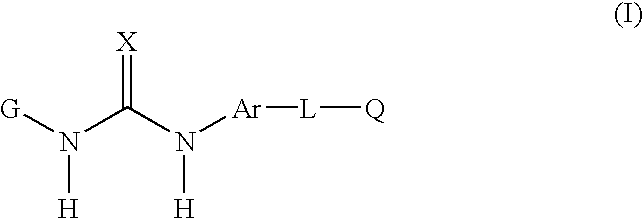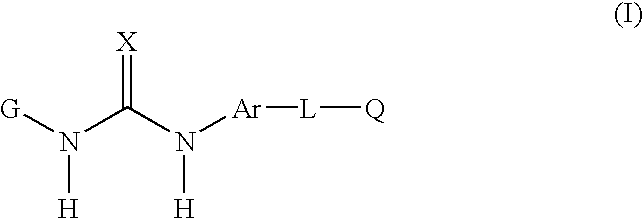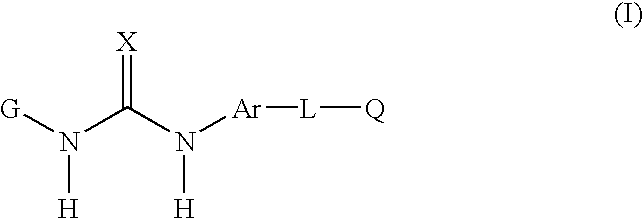Compounds useful as anti-inflammatory agents
- Summary
- Abstract
- Description
- Claims
- Application Information
AI Technical Summary
Benefits of technology
Problems solved by technology
Method used
Image
Examples
example 1
(Method F): Synthesis of 5-tert-butyl-2-methylaniline
##STR6##
To a solution of 4-tert-butyl toluene (5 g, 33.7 mmol) in acetonitrile (150 mL) at 0.degree. C. was added nitronium tetrafluoroborate (5.83 g, 40.5 mmol). After 30 min at room temperature, the reaction was diluted with water (50 mL) and extracted with ethyl acetate (3.times.30 mL). The combined organic extracts were washed with brine and dried (MgSO.sub.4). Removal of the volatiles in vacuo left a residue which was purified by flash chromatography using 10% methylene chloride in petroleum ether as eluent. Concentration in vacuo of the product rich fractions provided 3.8 g of 4-tert-butyl-2-nitrotoluene.
4-tert-Butyl-2-nitrotoluene (200 mg, 1.1 mmol) was dissolved in DMF (10 mL). The catalyst (10% Pd / C, 5 mg) was added and the system was purged with argon then exposed to H.sub.2 (1 atm) for 12 h. The mixture was filtered over a pad of diatomaceous earth and the filtrate was diluted with water and extracted with ethyl acetate...
example 2
(Method G): Synthesis of 6-tert-butyl-2-chloro-3-methylpyridin-yl-isocyanate
##STR7##
A mixture of 2-t-butyl-6-chloro-5-methylpyridine-4-carboxylic acid methyl ester (2.27 g, 9.39 mmol) and LiOH monohydrate (2.36 g, 56.3 mmol) in methanol (30 mL) and water (10 mL) was stirred at room temperature for 24 h. Removal of the volatiles in vacuo provided a residue which was purified by chromatography on silica gel using 5% TFA in dichloromethane as the eluent. Concentration in vacuo of the product rich fractions provided the corresponding carboxylic acid (1.41 g, 66.3%).
To a stirred solution of the above carboxylic acid (0.54 g, 2.36 mmol) and triethylamine (0.66 mL, 4.75 mmol) in THF (6 mL) at -10.degree. C. ethyl chloroformate (0.34 mL, 3.51 mmol) was added dropwise. The resulting mixture was stirred at 0.degree. C. for 1 h. A solution of sodium azide (0.40 g, 6.0 mmol) in water (2 mL) was added and stirring was continued for another 1 h. The mixture was extracted with toluene. The organic...
example 3
(Method H): Synthesis of 5-tert-butyl-2-(1H-pyrazol-4-yl)aniline
##STR8##
Methyl 4-t-butylphenylacetate (20 mmol) was dissolved in MeOH (160 mL) and treated with water (40 mL) and LiOH monohydrate (30 mmol). The reaction was allowed to stir at room temperature overnight. The volatiles were removed under reduced pressure and the remaining residue was diluted with water and neutralized to pH 4 with 1 N sulfuric acid. The resulting solids were filtered, washed with water and dried to leave 4-t-butylphenylacetic acid as an off-white solid (3.8 g, 99%).
Anhydrous DMF (139 mmol) was cooled to 0.degree. C. and treated with POCI.sub.3 (79.6 mmol). After 5 min, 4-t-butylphenylacetic acid (19.9 mmol) was added and the mixture heated at 110.degree. C. for 2 h, cooled to room temperature and poured into a stirred solution of NaPF.sub.6 (19.8 mmol) in water (200 mL). The solid was filtered, washed with water, and dried (7.8 g, 97%).
A mixture of the above salt (5 mmol) and hydrazine hydrate (5 mmol)...
PUM
| Property | Measurement | Unit |
|---|---|---|
| Time | aaaaa | aaaaa |
| Angle | aaaaa | aaaaa |
| Angle | aaaaa | aaaaa |
Abstract
Description
Claims
Application Information
 Login to View More
Login to View More - R&D
- Intellectual Property
- Life Sciences
- Materials
- Tech Scout
- Unparalleled Data Quality
- Higher Quality Content
- 60% Fewer Hallucinations
Browse by: Latest US Patents, China's latest patents, Technical Efficacy Thesaurus, Application Domain, Technology Topic, Popular Technical Reports.
© 2025 PatSnap. All rights reserved.Legal|Privacy policy|Modern Slavery Act Transparency Statement|Sitemap|About US| Contact US: help@patsnap.com



